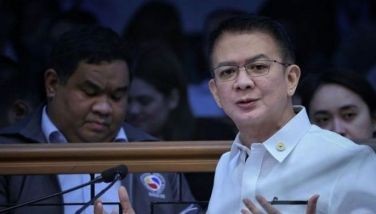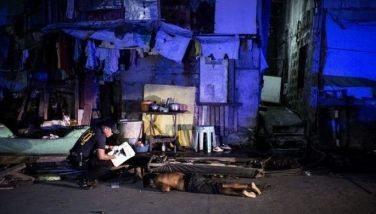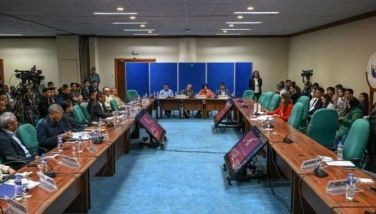Numbers tell the truth
Ms Sara Soliven-De Guzman,
I take exception to your column “It’s the moment of truth for Senator Revilla” appearing in “As A Matter of Fact” on Nov. 10, 2014.
Without actual basis, you claim that the Ombudsman have nailed the plunder case against Revilla and continues that they clearly have a strong case against the Senator.
Without regard to the sub judice rule, you have blatantly jumped the gun on the Sandiganbayan, as if to influence their appreciation and findings, and to condition the public’s mind on your desired outcome of the proceedings.
Taking a cue from your column, as a matter of fact, coming from someone who was present and observed every hearing of Senator Revilla’s case, your conclusions could not be farther from the truth. This is because I am sure you did not attend any of the hearings, even for just once, so that you could not have made a responsible conclusion that is expected of a journalist.
When the scandal broke, the public was bombarded with the number P10,000,000,000, as in P10 billion. Accusations that P10 billion were pocketed was rife in media, force-feeding this number to the information-hungry masses. But what does this number truly reflect?
To this date, it is unclear how this number was reached and no solid nor concrete basis have been cited. If we are to look at the Commission on Audit (COA) Special Audit Report on the PDAF, the investigation reports of the Ombudsman Field Investigation Office (FIO) and the affidavits of self-styled whistleblowers, the number 10 billion is nowhere to be found.
In fact, looking at the aggregate amount in the charges that were filed by the Ombudsman with the Sandiganbayan, 10 billion is not even in the ballpark because the total amount does not even reach P1 billion.
In the case of Sen. Ramon Bong Revilla Jr., he was first accused of pocketing P1.2 billion. A number so glaring, it elicits a natural sense of disgust, anger, and condemnation. This accusation was printed in big, bold letters, and recited in broadcast media, the effects of which continue to resonate in public sentiment.
However, this number, like the 10 billion, continues to have no actual basis at all.
Following the progress of Revilla’s case, the number 1.2 billion was reduced to a third during the Senate Blue Ribbon Committee hearings – or to 400 million, a new number. When the Ombudsman filed a case against Revilla with the Sandiganbayan, the number was further reduced by almost half – or to 224 million. As the trial for Revilla’s bail petition proceeded, this new number was again reduced to almost a third – or to just over 80 million. But unlike the numbers 10 billion and 1.2 billion, these numbers were never printed in bold nor broadcast as loudly.
When the Anti-Money Laundering Council (AMLC) testified through Bank Investigator Atty. Leigh Von Santos in Revilla’s Bail Petition hearings, numbers were again used to lead the public to believe that they found evidence Revilla received kickbacks as alleged by his accusers.
But in fact, what the AMLC actually and merely found, in simple and unequivocal terms, is that in a span of 5 years, from 2006 to 2010, Revilla made multiple deposits amounting to 87 million involving only 5 accounts. That is not even 20 million per year on the average. For a man of Revilla’s earning capacity, it is not a cause for surprise, or if at all, the number is actually surprisingly low.
So low that for the past 10 years or so, the AMLC never saw anything suspicious in Revilla’s accounts. In fact, in their first investigation into Revilla finances, they found nothing to raise any suspicion. Only when the Ombudsman asked them to conduct an investigation and fed them Benhur Luy’s accusations did the AMLC say there were suspicious transactions.
In finding 1:1 or matching correspondence, the AMLC used as an absolute basis, the alleged ledger of Benhur Luy found as an annex in his first of many affidavits. The AMLC no longer read the following affidavits of Luy where he contradicted his previous claims. The ledger he claims to have prepared by himself, have indications that they were prepared by someone else, and stolen by him.
Luy claims that the numbers in his Hard Disk Drive are irrefutable, and the Ombudsman’s prosecutors presented an NBI Digital Forensic Officer to authenticate the contents of the Drive. They would want to make the public believe that the numbers in Luy’s HDD is enough to support the findings of the AMLC and convict Revilla.
However, the prosecution miserably failed to authenticate the HDD and the numbers Luy keeps peddling.
The NBI admitted that Luy’s HDD is not an exact copy of the JLN computer’s HDD, which should have been the one subjected to examination. They admitted that they did not exert efforts to find and seize the original HDD. The NBI also admitted that they did not get the owner of the files consent in examining the Drive.
In testifying, the NBI admitted that their examination of the HDD did not tell them who actually or personally created the files, who actually or personally accessed the files, and what revisions or modifications were introduced to the files.
In other words, the NBI admitted they did not personally see the files being created/modified/changed; who created the files; who modified; or who last saved the files.
Intriguingly, during the cross-examination of NBI’s witness Joey Narciso himself said that there were files created on the year 2004, 2005, and 2007, but were all “last saved” on 2013 – 9, 8, and 6 years after they were created. Interestingly, Luy was already in the custody of the NBI and under the Witness Protection Program during this time.
During cross-examination, Narciso also admitted he was not 100% sure of the integrity of the hard drive since the hash values of the files therein and in the possession of the Ombudsman were different from the hash values of those submitted by the NBI to the Senate. He also admitted that his conclusions were based merely on his personal inference and not on the specialized software “Encase” which he used in examining the HDD.
Narciso also admitted to examining the HDD twice. On first examination, he had no conclusions and referred the matter to his supervisor and the Special Prosecutors. Only after he was given specific instructions and directions on how the examination should be conducted and fed names that should be included in the report, was he able to finally reach a conclusion.
So in effect, the NBI failed to establish the authenticity of the files and the numbers in Luy’s Disk Drive, and haplessly failed to establish, that it was Luy who created, modified and saved the files.
As an aside and speaking of numbers, Luy’s computations made in Court failed to even match what was written on his alleged ledger contained in his HDD.
What Luy did instead was admit to falsifying PDAF and other financial documents, forging signatures, and fabricating accounting entries.
If you have looked at the AMLC report submitted to the Sandiganbayan, there is not even any basis for the AMLC to conclude there was a 1:1 or matching correspondence. One does not need any specialization in any mathematical field to see that there is no 1:1 or matching correspondence.
To believe otherwise like how the AMLC would want us to accept, is to concede that 250,000 = 5,000,000; that 200,000 = 12,500,000; that 100,000 = 7,000,000; that 200,000 = 10,000,000; that 600,000 = 10,000,000; that 500,000 = 17,250,000; that 700,000 = 18,000,000; and that 87M = 224M.
Also, we must believe that time travel is now possible because Revilla was able to deposit in his account on December 11, 2008 the money he allegedly received a day after that, or only on December 12, 2008.
In making its conclusions, the AMLC disregarded the 2 accounts belonging to the spouses Revilla where their income as actors are remitted. They did not look into matching the outflow of funds from these accounts to the inflow of funds to the accounts they presumed were suspicious. Had they done that, they would have seen that the sources of Revilla’s funds were indeed legitimate.
So, by allowing the AMLC report against Revilla to speak and truly represent what it means, the numbers are clearly saying that there is no basis nor indication that Revilla received P224,512,500. Likewise, there is basis and indications that he did not receive P224,512,500.
These alone belie your claim made in the column.
Furthermore, there is no truth to the prosecution’s claim that Revilla’s request to allow him to undergo a medical check-up is “a tactic to delay the case and could be a prelude to hospital arrest.”
No detainee would ever want to delay proceedings of his case as this necessarily means longer jail time.
In fact, it is the prosecution who use delaying tactics such as when the NBI witness missed 2 trials for being ‘under the weather.’ But it was later found out that the witness was in an Ombudsman press conference during one of his absence. This is a clear indication that it is the prosecution and not Revilla who wants the case to be delayed.
Taking these into consideration, and what has actually transpired in Court, I cannot believe in your conclusion that there is a case against the Senator, more so any evidence against him.
It is true that it is the moment of truth for Senator Revilla — the moment when truth prevails over lies, and that genuine justice is served. It is the moment when the persecution is exposed. — Amelia Manzo, Media Relations Officer, Office of Senator Ramon Bong Revilla Jr.
- Latest




















